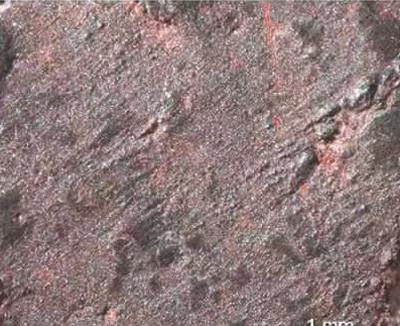Source: Overseas Network

Friction marks on the surface of small pieces of hematite found at the site of the Lower Horse Monument. Courtesy of the State Administration of Cultural Heritage
A few days ago, the State Administration of Cultural Heritage held a working meeting on the important progress of the "Archaeological China" major project in Beijing, and reported the latest progress in archaeological discoveries and research in Nihe Bay, Hebei Province. According to reports, this discovery is the earliest known archaeological remains of prehistoric human processing of pigments and inlaid with fine stone tools in mainland China and even East Asia, which is of great value for interpreting the development process of human culture in the Paleolithic period in East Asia and the world.
According to relevant experts from the Hebei Provincial Institute of Cultural Relics and Archaeology, the Nihewan site group refers to the Paleolithic sites distributed in the Nihewan Basin. Originally, the Nihewan Basin mostly referred to the Yangyuan County, also known as the "Yangyuan Basin". At present, the concept of Nihewan Basin extends to the vast areas of Weixian Basin, Huailai Basin, Zhuolu Basin and Datong Basin in Shanxi, also known as the Broad Nihewan Basin.
The important progress of the "Archaeology China" major project will focus on the latest progress of archaeological discoveries and research in Nihe Bay. The 6th layer of the Xiama Monument site in Weixian County is piled up 41,000 to 39,000 years ago, and archaeology has found hematite ore, fire ponds and scattered stone tools, bone tools and animal fossil fragments around it. According to the analysis of Raman spectroscopy, X-ray fluorescence spectroscopy and other technologies, it was confirmed that a staining area enriched with hematite was confirmed, and friction marks were found on the surface of some hematite ore, which were speculated to be the remains of pigment processing. Excavated stone tools are mainly slender small stone tools made of smashing, and some of the fine stone tools have found bone stalk residues and linear arrangement of plant fiber residues on the surface, which is speculated to be a composite tool made by ancient humans through stalks and inlays, which were used to drill holes, process furs, cut plant and animal soft tissues, etc.
The relevant person in charge of the State Administration of Cultural Heritage said that the Nihe Bay Archaeological Project reported this time is an important result of Paleolithic archaeological research, which more vividly explains the human culture, technology and environment, aesthetics and spiritual world of the Paleolithic era on the mainland, which has important value.
The archaeology of Nihe Bay has gone through nearly 100 years (Extended reading)
After several generations of archaeologists in the past hundred years of continuous struggle, the archaeology of Nihe Bay has achieved fruitful results. Archaeology has found more than 500 Paleolithic sites from the middle of the Early Pleistocene to the end of the Late Pleistocene.
Among them, the Maquangou site group confirmed 17 paleoanthropological cultural layers dating from 1.76 million to 1.26 million years ago, 7 cultural layers dating from 1.36 million to 1 million years ago were found in the Xiaochangliang-Donggutuo area, and the Maliang-Hougou site group preserved 9 cultural layers dating from more than 800,000 to 350,000 years ago.
Recent excavations at the Houjiayao site have revealed a complete stratigraphic profile. The Banjingzi site unearthed stone core stripping pieces that were prefabricated and repaired between 100,000 and 86,000 years old. The site of The West White Horse Camp has found 45,000-year-old fire remnants and sites for dismemberment and disposal of animal resources, which is speculated to be a temporary camp for ancient humans. Sites such as the oil house have found remnants of stone leaf technology dating back 29,000 to 27,000 years, which are of great value for exploring the emergence and diffusion of stone leaf and fine stone leaf technology in North China, and cultural exchanges between the East and the West.
The Discovery of Fire Ponds, Fine Stone Leaf Technology Stone Tools, Ornaments and Pottery Pieces dating back to 20,000 to 10,000 years ago in the Hutouliang site group provides a scientific and reliable stratigraphic and cultural basis for exploring the transition from paleolithic to Neolithic. (Reporter Zhao Xiaoxia)
People's Daily Overseas Edition ( 2022-03-07 Edition 11)